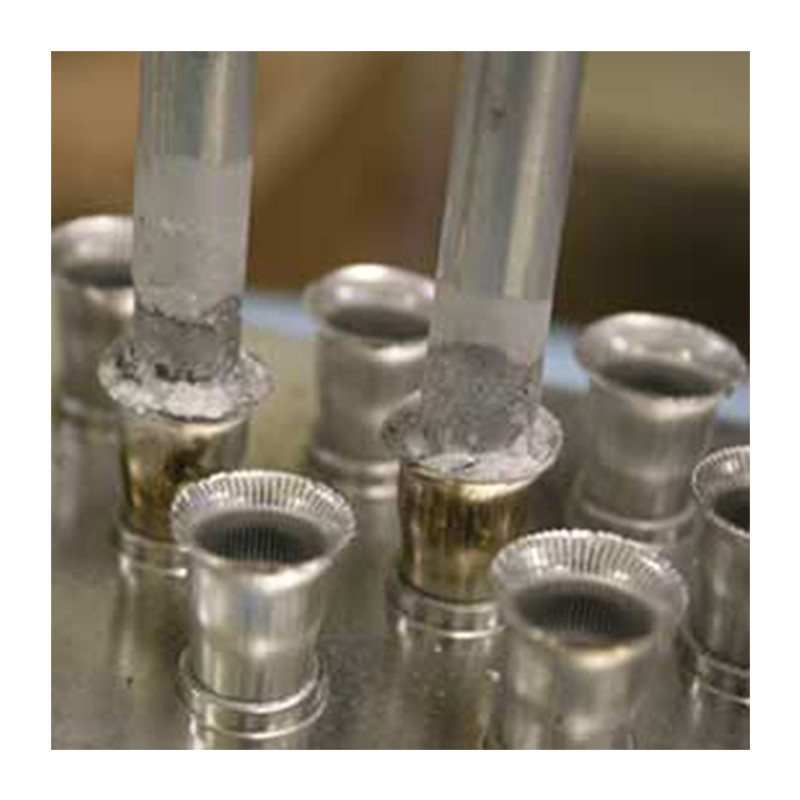

Jūs turite būti prisijungę
Category


Nuotraukos yra skirtos tik informaciniams tikslams. Peržiūrėkite produkto specifikaciją
please use latin characters
Kietasis litavimas – tai metalinių elementų sujungimo procesas naudojant lydmetalius, kurių lydymosi temperatūra yra aukštesnė nei 427 °C, bet žemesnė nei jungiamų dalių. Šis metodas leidžia sujungti tiek vienodus, tiek skirtingus metalus.
Lituoti sujungimai:
Lydmetalio rūšis, naudojama kietajame litavime, priklauso nuo jungiamų dalių. Dažniausiai naudojami vario-fosforo, sidabro, aliuminio, vario, nikelio ir kobalto lydmetaliai.
Šiuolaikinė indukcinio šildymo įranga užtikrina patikimą, bekontaktį ir energiją taupantį kaitinimą per minimalų laiką, nenaudojant liepsnos. Vieno indukcinio kaitinimo ciklo trukmė yra daug trumpesnė nei kaitinimo liepsna metu, todėl per tą patį laiką galima apdoroti daugiau detalių, išskiriant mažiau šilumos į aplinką. Indukcinis litavimas leidžia kontroliuoti laiką, temperatūrą, detalių fiksavimą ir padėtį, todėl procesas yra pakartojamas ir užtikrina vienodą galutinį rezultatą.
Puslaidininkių sistemos gali kaitinti labai mažus plotus tiksliai laikantis gamybos proceso tolerancijų, nepažeisdamos metalurginių savybių. Didelės apimties ar aukštos kokybės reikalavimų procesuose detalės gali būti lituojamos indukciniu būdu inertinėje atmosferoje be fliuso ir brangių valymo procedūrų, taip sumažinant oksidaciją.
Ar Jūs domina šis produktas? Ar Jums reikia papildomos informacijos ar individualaus pasiūlymo?
tu turi būti prisijungęs
Kietasis litavimas – tai metalinių elementų sujungimo procesas naudojant lydmetalius, kurių lydymosi temperatūra yra aukštesnė nei 427 °C, bet žemesnė nei jungiamų dalių. Šis metodas leidžia sujungti tiek vienodus, tiek skirtingus metalus.
Lituoti sujungimai:
Lydmetalio rūšis, naudojama kietajame litavime, priklauso nuo jungiamų dalių. Dažniausiai naudojami vario-fosforo, sidabro, aliuminio, vario, nikelio ir kobalto lydmetaliai.
Šiuolaikinė indukcinio šildymo įranga užtikrina patikimą, bekontaktį ir energiją taupantį kaitinimą per minimalų laiką, nenaudojant liepsnos. Vieno indukcinio kaitinimo ciklo trukmė yra daug trumpesnė nei kaitinimo liepsna metu, todėl per tą patį laiką galima apdoroti daugiau detalių, išskiriant mažiau šilumos į aplinką. Indukcinis litavimas leidžia kontroliuoti laiką, temperatūrą, detalių fiksavimą ir padėtį, todėl procesas yra pakartojamas ir užtikrina vienodą galutinį rezultatą.
Puslaidininkių sistemos gali kaitinti labai mažus plotus tiksliai laikantis gamybos proceso tolerancijų, nepažeisdamos metalurginių savybių. Didelės apimties ar aukštos kokybės reikalavimų procesuose detalės gali būti lituojamos indukciniu būdu inertinėje atmosferoje be fliuso ir brangių valymo procedūrų, taip sumažinant oksidaciją.
Jūsų atsiliepimo įvertinimas negali būti išsiųstas
Pranešti apie komentarą
Pranešimas apie atsiliepimą išsiųstas
Jūsų pranešimas apie atsiliepimą neišsiųstas
Parašyti savo atsiliepimą
Atsiliepimas išsiųstas
Jūsų atsiliepimas neišsiųstas
